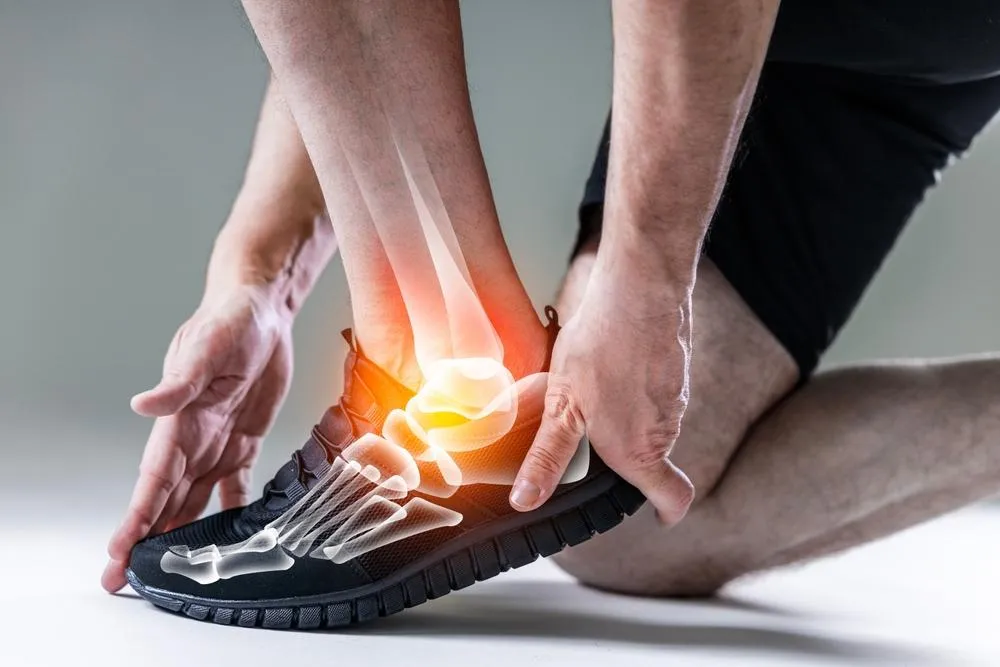SPORTS INJURIES
Common Sports Injuries in Podiatry
Sports injuries are a frequent concern among active individuals, especially those who engage in high-impact activities such as running, tennis, and aerobics. These injuries often affect the feet and ankles, requiring specialized care to ensure a full recovery. Here, we explore the most common sports injuries treated in podiatry clinics and the best practices for their management.

Types of Sports INJURIES
1. Ankle Sprains:
Ankle sprains occur when the ligaments that support the ankle stretch or tear, often due to a sudden twist or fall. Symptoms include pain, swelling, and difficulty walking.
2. Stress Fractures:
Stress fractures are small cracks in the bone, commonly seen in the metatarsals of the foot. They result from repetitive stress or overuse and cause localized pain and tenderness.
3. Achilles Tendinitis:
This condition involves inflammation of the Achilles tendon, which connects the calf muscles to the heel bone. It is often caused by a sudden increase in physical activity.
4. Plantar Fasciitis:
Plantar fasciitis, characterized by pain in the heel and bottom of the foot, is common among runners and athletes who engage in activities that place excessive stress on the feet.
5. Shin Splints:
Shin splints refer to pain along the shin bone, often due to repetitive stress from running or jumping activities.
6. Turf Toe:
Turf toe is a sprain of the big toe joint resulting from hyperextension. It is prevalent in athletes who play on artificial turf.
7. Peroneal Tendonitis:
This condition involves inflammation of the peroneal tendons, which run along the outer side of the ankle and foot. It often results from repetitive ankle motion or overuse, causing pain and swelling on the outside of the foot and ankle.
Preventing Sports Injuries
Proper Warm-Up and Cool-Down
Always warm up before and cool down after physical activity to prepare muscles and reduce the risk of injury.
Wear Appropriate Footwear
Choose shoes that provide adequate support and are designed for the specific sport.
Gradual Progression
Increase the intensity and duration of activities gradually to avoid overuse injuries.
Strength and Flexibility Training
Incorporate exercises that enhance strength and flexibility, particularly in the lower extremities.
Listen to Your Body
Pay attention to pain and discomfort, and do not push through injuries. Rest and seek medical advice when needed.
Diagnosing Sports Injuries
Accurate diagnosis is crucial for effective treatment. Podiatrists use a combination of physical examinations, patient history, and imaging techniques such as X-rays or ultrasound to diagnose sports injuries.
Treatment Options
Rest and Ice:
Initial treatment often involves resting the injured area and applying ice to reduce inflammation and pain.
Compression and Elevation:
Using compression bandages and elevating the injured limb can help minimize swelling.
Physical Therapy:
A physical therapist can design a rehabilitation program based on the injury type, focusing on strength and flexibility.
Orthotic Devices:
Custom orthotic inserts can provide support and alleviate stress on the injured area.
Medications:
Nonsteroidal anti-inflammatory drugs (NSAIDs) can help manage pain and inflammation.
Surgery:
In severe cases, such as complex fractures or tendon ruptures, surgical intervention may be necessary.
When to See a Podiatrist
Persistent symptoms such as pain, swelling, or limited mobility should be assessed by a podiatrist. Timely evaluation can prevent further damage and support effective recovery.
SERVICING BRISBANE'S WESTERN SUBURBS
Neat Feet Podiatry Care
Marshall Lane Health Clinic
8 Marshall Lane, Kenmore QLD 4069
Monday - Closed
Tuesday 9am - 5pm
Wednesday 8am - 4pm
Thursday 10am - 6pm
Friday 9am - 5pm

